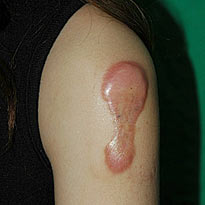Keloids treatment
There are many ways to treat keloids like corticosteroids, liquid nitrogen, radioactive phosphorus . The most advanced method is to use lasers.
 When the wound starts to heal, at the site of the wound forming scar. Many cases of scarring become larger, protruding and floating on the skin surface, causing itching, pain, entanglement, and especially aesthetic .
When the wound starts to heal, at the site of the wound forming scar. Many cases of scarring become larger, protruding and floating on the skin surface, causing itching, pain, entanglement, and especially aesthetic .
Keloid scars are caused by overgrowth, thickening of collagen in the dermis and under the skin during wound healing. Keloid scars often do not self-decrease but tend to grow again after being cut off.
For normal people, keloids often appear in facial areas; lower neck; upper chest, abdomen. Keloids may occur after a number of cosmetic surgeries such as facial stretches, breast implants, belly fat cutting. Surgery for goiter, heart, stomach, appendix, cesarean section . can also lead to keloids.
In yellow skin, the incidence of keloids is very high, accounting for 15-20%. For people with keloids, any skin lacerations, including needles, can produce keloids at that location.
Dr. Ly Huu Duc, HCM City Dermatology Hospital, said there are many ways to treat keloids:
Corticosteroid injections for small atrophic scars: There must be techniques and experiences because if deep injections will create concave scars, and too shallow, the scar will not go away and the sores will expand. This method is applied in many private salons and clinics. Corticosteroids can cause many side effects (if used a lot) such as water retention, hirsutism, acne, skin atrophy, hypertension, diabetes .
Liquid nitrogen dots : Cold air causes scarring, but if not done properly, it will cause cold burns around the scar, making more protrusions.
Paste radioactive phosphorus : After gluing, the scar is flat but there is also a case of spreading. Currently, Dermatology Hospital has stopped treatment with this method ".
Projecting a dye-colored pulse laser (PDL), with a wavelength of 585-595 nm: The laser destroys blood vessels to nourish the scar, cause ischemia of the scar area, stop development and gradually reduce the size and thickness of the scar.
Dr. Tran Thi Anh Tu, Ho Chi Minh City Medical Training and Retraining Center, commented: Each method of treating keloid scars has its own advantages. In order to achieve rapid treatment, PDL lasers should be used in combination with many other methods, suitable for each specific case.
Although laser technology does not completely disappear keloids, it can quickly narrow the size and thickness of the scar, make the scar softer, less painful, less itchy, and especially reduce the redness of the scar. scarring, bringing skin quickly back to normal color. Effectiveness depends on scarring, time of scarring, age . but is usually achieved after about a few treatments. New scars are faster and more effective than older scars.
- HIV exposure and treatment
- Successful development of antibodies that treat Ebola
- Inauguration of a centralized wastewater treatment plant
- Important findings about treatment for HIV in 2011
- New treatment regimens can leave H1N1 patients
- The new method helps shorten the duration of treatment for TB
- Unique 'technology' hospital wastewater treatment with reeds
- $ 140 million to build the largest waste treatment plant in Vietnam
- Clean water treatment system from snack bags
- Waste treatment solution for hospitals in Vietnam
- Scary healing therapies in the early twentieth century
- HIV infection can still last up to 70 years
 Green tea cleans teeth better than mouthwash?
Green tea cleans teeth better than mouthwash? Death kiss: This is why you should not let anyone kiss your baby's lips
Death kiss: This is why you should not let anyone kiss your baby's lips What is salmonellosis?
What is salmonellosis? Caution should be exercised when using aloe vera through eating and drinking
Caution should be exercised when using aloe vera through eating and drinking